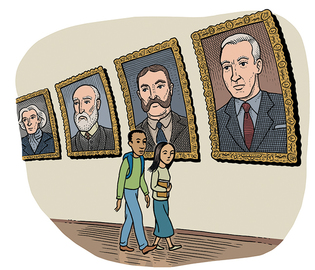 loading
loading
FindingsWho belongs?A study looks at what the portraits on the med school walls say to students.  Gregory NemecView full imageWalls lined with portraits of past Yale medical luminaries—almost all of them white men—lead some medical students to feel that they themselves don’t belong at the school, a recent study found. Two students interviewed 15 of their peers, asking them open-ended questions about their thoughts on the paintings in the Sterling Hall of Medicine. The portraits feature 52 white men and 3 white women. Some students said the portraits displayed values of whiteness, elitism, maleness, and power. Some felt “judged and unwelcome”; one said, “If these portraits could speak, they would not be so excited about me . . . being a student here.” Some reported joking about the portraits or avoiding Sterling altogether. “For many interviewed students, the portraiture signified that they did not fit the model of the ideal Yale physician,” wrote coauthors Nientara Anderson ’06, ’20MD, and Elizabeth Fitzsousa ’21MD. (The study is online in the Journal of General Internal Medicine.) To many women students and students of color, the portraits represent a constant force of disapproval, says Anderson. Medical students of color, she adds, often already face challenges to their right to care for patients in the hospital. Other researchers have found that students who feel they’re on the margins may experience greater stress, potentially eroding their ability to succeed. What should become of the portraits? It’s hard to know, but the conversation has begun, Anderson says. “In recent years, this is the first time this question is being raised with such force,” she adds. “There’s no road map.”
|
|
1 comment
-

Michael DiGiacomo, 7:49pm November 14 2019 |  Flag as inappropriate
Flag as inappropriate
The comment period has expired.Regarding "Who Belongs?" (Nov.-Dec.), I take it as given that the men and women whose portraits hang in the med school halls are there because of outstanding contributions to medicine, Yale, or both. They looked the way they looked because that was who they were. Times have changed, but history doesn't. Any current med student who feels "judged and unwelcome" or "disapproved" because of those portraits should reconsider joining a profession that requires empathy, compassion, acceptance of human imperfection, courage, realism, and self-confidence.
Michael DiGiacomo YC '68 (in memory of my physician father)